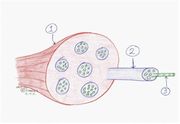Module III, Muscles and Movement
Product Description
I. Rules that skeletal muscles ‘live’ by! pg. 4-17
(Spaghetti muscle activity)
II. Identification of Muscle Movement and Location pg. 18-30 (Flexors vs. Extensors)
III. Identification of Muscles (there is an easier way!) pg. 30-56 (Muscle groups, diagrams, & flashcards)
IV. Muscle Contraction pg. 57-73 (spaghetti for sarcomeres!)
V. The Nerve Connections to Muscles and Motor Units pg. 74-78
VI. Muscle Twitch and Strength of Contraction pg. 79-81
VII. ATP and ATP Regeneration pg. 81-92
VIII. Skeletal muscle comparison with cardiac and smooth muscle pg. 92-94
Preview:
Hand out the bottom diagram on page 14 or have students look at a diagram in the book as they find the following structures on their spaghetti model.
c. The outer wrap of the spaghetti muscle is the CT that sits ‘on top’ of the muscle known as Epimysium. (Epi=sit on top of; myo=muscle) ( #1 on the diagram)
The epimysium is sometimes referred to as fascia.
d. Students slowly unwrap the epimysium off of their spaghetti muscle and notice the several fascicles, which the students have come to know as a team of muscle fibers. (#2 on the diagram)
Have students notice the wrinkles on the surface of the belly of the spaghetti muscle and the covering of the fascicle. These wrinkles represent the dense irregular CT that wraps the muscle.
e. Around each fascicle, student identify that this dense irregular CT wrap is known as Perimysium. (peri=around)
f. Students slowly unwrap one of the fascicles and pull out one strand of spaghetti. Notice the color of the strand and that the muscle fiber has a thin covering (areolar CT) known as endomysium. (endo=inside) (#3 on the diagram)
II. Identification of Muscle Movement and Location pg. 18-30 (Flexors vs. Extensors)
III. Identification of Muscles (there is an easier way!) pg. 30-56 (Muscle groups, diagrams, & flashcards)
IV. Muscle Contraction pg. 57-73 (spaghetti for sarcomeres!)
V. The Nerve Connections to Muscles and Motor Units pg. 74-78
VI. Muscle Twitch and Strength of Contraction pg. 79-81
VII. ATP and ATP Regeneration pg. 81-92
VIII. Skeletal muscle comparison with cardiac and smooth muscle pg. 92-94
Preview:
Hand out the bottom diagram on page 14 or have students look at a diagram in the book as they find the following structures on their spaghetti model.
c. The outer wrap of the spaghetti muscle is the CT that sits ‘on top’ of the muscle known as Epimysium. (Epi=sit on top of; myo=muscle) ( #1 on the diagram)
The epimysium is sometimes referred to as fascia.
d. Students slowly unwrap the epimysium off of their spaghetti muscle and notice the several fascicles, which the students have come to know as a team of muscle fibers. (#2 on the diagram)
Have students notice the wrinkles on the surface of the belly of the spaghetti muscle and the covering of the fascicle. These wrinkles represent the dense irregular CT that wraps the muscle.
e. Around each fascicle, student identify that this dense irregular CT wrap is known as Perimysium. (peri=around)
f. Students slowly unwrap one of the fascicles and pull out one strand of spaghetti. Notice the color of the strand and that the muscle fiber has a thin covering (areolar CT) known as endomysium. (endo=inside) (#3 on the diagram)
